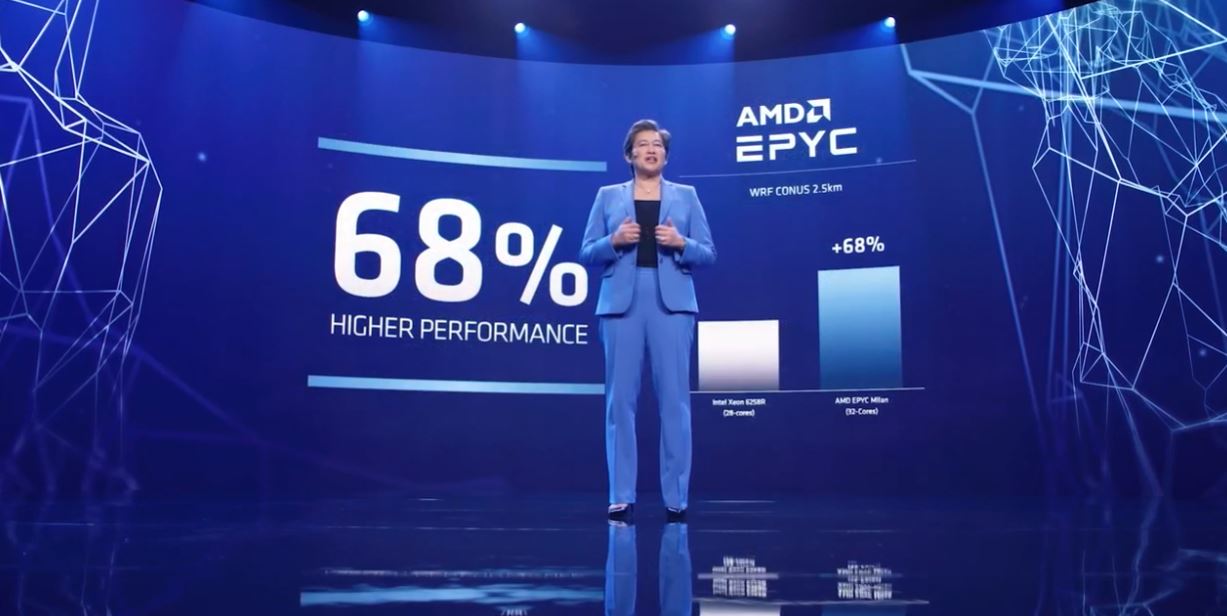AMD’s 32-Core EYPC Milan Processors Beat Intel’s Flagship Xeons in Demo
Zen 3 gets 64 cores
AMD CEO Dr. Lisa Su demoed the company’s upcoming third-gen EPYC Milan processors at CES, showing one of its 32-core models outperforming a 28-core Intel Xeon Scalable processors in a weather research and forecast (WRF) workload by 68%. The demo also possibly foreshadows AMD’s pricing strategy with its 32-core EPYC Milan models.
As with the current-gen EPYC Rome processors, AMD fabs the EPYC Milan chips with the 7nm process, and they top out at 64 cores. The most significant change to the series comes with the infusion of the Zen 3 microarchitecture that lends a 19% in instruction per cycle (IPC) throughput improvement courtesy of changes like a unified L3 cache and better thermal management techniques that allow the chip to extract more performance within any given TDP range.
Here we can see two unnamed 32-core AMD Milan processors going head-to-head with two of Intel’s 28-core Xeon 6258R processors. This may seem like a bit of a lopsided comparison, but the performance delta, and AMD’s traditionally much less-expensive price points, factor into the importance of the benchmark results.
The WRF workload relies on large datasets, so data ingest performance is critical. Milan should have an advantage in this area, as it’s thought to come with the same 128 PCIe 4.0 lanes and eight channels of DDR4 support as the existing Rome models. (AMD’s Rome already has the connectivity advantage over Intel’s Xeon Scalable processors.) The benchmark runs a real-world workload to create a six-hour weather forecast.
AMD’s single-socket results show a 68% performance advantage over Intel’s chips, and the nature of the comparison might foreshadow AMD’s pricing strategy for its new line of processors - it’s rational to expect the 32-core EPYC Milan models to land at similar or lower pricing than the $3,950 Xeon 6285R.
Milan’s increased IPC throughput floats all boats in terms of performance, but it tends to have the biggest impact on per-core performance. This is an essential aspect of performance for customers that license software on a per-core basis because it results in lower licensing fees.
Naturally, we can only imagine how this performance comparison would stack up against two of AMD’s 64-core models - the Xeon 6258R represents the height of Intel’s Xeon performance with the maximum of 28 cores.
Get Tom's Hardware's best news and in-depth reviews, straight to your inbox.
We won’t have to wait long - AMD says EPYC Milan is on track will have its formal launch later this quarter. However, the EPYC Milan chips began shipping to select cloud and HPC customers in the last quarter of 2020, while the formal launch signifies availability for Tier 1 OEMs. That’s also evident by a string of benchmark results that have surfaced for both the 64-core and 32-core models.
AMD’s early Milan shipments to HPC partners are critical: Milan has already enjoyed explosive uptake in the supercomputer space and is slated to power the world’s soon-to-be-fastest supercomputer, the exascale-class Frontier, and the Perlmuter supercomputer, among many others.
The EPYC Milan Tier 1 OEM launch comes soon, but the competitive landscape could change in the interim - Intel’s 10nm Ice Lake processors are also slated for release in the same time frame.

Paul Alcorn is the Editor-in-Chief for Tom's Hardware US. He also writes news and reviews on CPUs, storage, and enterprise hardware.
-
Makaveli The demo on stage is Intel 56 cores vs AMD 64 cores.Reply
Intel Xeon Gold 6258R 28 Cores x 2, AMD EPYC 7543 32 cores x 2
It was addressed in the details of the article however title is still misleading. -
lightofhonor ReplyMakaveli said:The demo on stage is Intel 56 cores vs AMD 64 cores.
Intel Xeon Gold 6258R 28 Cores x 2, AMD EPYC 7543 32 cores x 2
It was addressed in the details of the article however title is still misleading.
It's a competitor in price, not cores. And even still, 15% more cores grants 68% higher performance. So ~38% better performance per core. -
Makaveli Replylightofhonor said:It's a competitor in price, not cores. And even still, 15% more cores grants 68% higher performance. So ~38% better performance per core.
This is good info and should be added to the article. -
Cobra617 I am a huge AMD fan but they are comparing an as of yet unreleased Milan processor to Intel's 2 year old Cascade Lake architecture (I get that the 6258R is 1 year old, but Cascade Lake is 2 years old).Reply
I want to see Milan vs Ice Lake. I still think AMD comes out on top. -
Rdslw Reply
It feels like they will be by like 35%. Intel needs to move to the lower node as at least half of the performance difference is the node used.Cobra617 said:I am a huge AMD fan but they are comparing an as of yet unreleased Milan processor to Intel's 2 year old Cascade Lake architecture (I get that the 6258R is 1 year old, but Cascade Lake is 2 years old).
I want to see Milan vs Ice Lake. I still think AMD comes out on top.
Still good job AMD for finally giving some fresh air into server space.
you could literally go into coma for 5years in 2012 and wake up see no changes.... -
jeremyj_83 Reply
Milan has been shipping to cloud partners already. In terms of the comparison, odds are AMD couldn't get a hold of an Ice Lake Xeon. Therefore they went with the current fastest Xeon they could acquire. Odds are that Ice Lake will only be able to compete with Rome based Epyc, but we won't know for quite until we see benchmarks.Cobra617 said:I am a huge AMD fan but they are comparing an as of yet unreleased Milan processor to Intel's 2 year old Cascade Lake architecture (I get that the 6258R is 1 year old, but Cascade Lake is 2 years old).
I want to see Milan vs Ice Lake. I still think AMD comes out on top.

